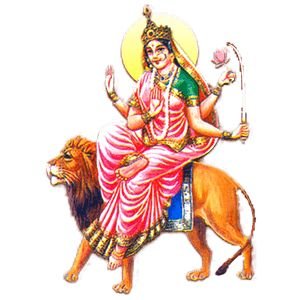Navratri Day 6, is dedicated to the worship of Maa Katyayani, an embodiment of strength and purity within Hindu mythology. This day holds profound significance for devotees seeking blessings for courage, fertility, and harmony in their lives.

As the rhythmic beats of the dandiya sticks echo through the air and the festive fervour continues to rise, we find ourselves immersed in the celebrations of the sixth day of Navratri. This day is dedicated to Maa Katyayani, the warrior goddess who embodies strength, courage, and determination. Her name is synonymous with fearlessness and unwavering devotion.
Table of Contents
Date and Color of Navratri Day 6:
Navratri Day 6, coinciding with the Shukla Shashthi tithi, represents the pinnacle of Navratri celebrations. Adorned in the vibrant hue of green, symbolizing vitality and growth, devotees honor Maa Katyayani’s fierce yet nurturing energy.
The Colour associated with Maa Katyayani: Red
Why is the colour red associated with the sixth day of Navratri, and how does it symbolise the fierce energy and passion of Maa Katyayani? In the vibrant tapestry of Navratri, each day is adorned with a unique colour, and on the sixth day, red takes centre stage. Red symbolises the fiery and passionate nature of Maa Katyayani. Donning red attire on this day is a way to connect with her fierce energy and seek her blessings for heroism and determination.
Rituals and Traditions
Devotees celebrate this day with unwavering devotion and enthusiasm. The day typically begins with a special puja (worship) dedicated to Maa Katyayani. Offerings of flowers, vermillion, and sacred scriptures are made to the goddess. Devotees recite prayers and mantras to invoke her strength and protection.
Shubh Muhurat:
The auspiciousness of the day begins with the Shukla Shashthi Tithi at 12:31 AM and extends until 11:24 PM. Embracing the divine timing, the Brahma Muhurta from 4:44 AM to 5:34 AM provides an ideal window for spiritual practices. Additionally, the Vijaya Muhurta (1:59 PM to 2:45 PM) and Sayahna Sandhya (5:47 PM to 7:03 PM) are opportune moments for invoking blessings.
Puja Vidhi:
Devotees embark on their spiritual journey by awakening early, purifying themselves with a sacred bath, and donning fresh attire as a symbol of reverence. The sanctified space is adorned with fragrant roses, illuminating lamps (Deepak), and aromatic incense sticks. As a gesture of devotion, lotus flowers are offered to Maa Katyayani, accompanied by the chanting of sacred mantras and heartfelt prayers.
Bhog:
A significant aspect of the worship ritual is the offering of honey, revered for its purity and sweetness. This divine offering symbolizes gratitude and devotion to Maa Katyayani, invoking her blessings for prosperity and well-being.
Mantras:
Devotees invoke the divine presence of Maa Katyayani through sacred mantras, including:
- “॥ Om Devi Katyayanyai Namah॥”
- “॥ Chandrahasojjvalakara Shardulavaravahana। Katyayani Shubham Dadyad Devi Danavaghatini॥”
- “॥ Ya Devi Sarvabhuteshu Ma Katyayani Rupena Samsthita Namastasyai Namastasyai Namastasyai Namo Namah॥”
These potent verses resonate with the essence of Maa Katyayani, invoking her divine grace to dispel negativity, overcome obstacles, and usher in peace and wisdom.
Frequency
There is no strict rule regarding the number of times you should chant the mantra. Some people may choose to chant it a specific number of times, such as 108 or 1008, while others may chant it continuously during their worship and meditation.The most important aspect is the intent and devotion with which you chant the mantra.
Navratri Day 6 stands as a testament to the enduring spirit of Maa Katyayani, inspiring devotees to embrace her virtues of courage, purity, and compassion as they navigate life’s journey with grace and fortitude.
